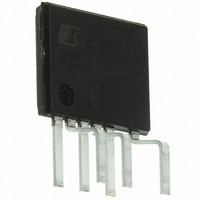LNK403EG Power Integrations, LNK403EG Datasheet - Page 10

LNK403EG
Manufacturer Part Number
LNK403EG
Description
IC LED DVR TRIAC 12W DIM SIP-7C
Manufacturer
Power Integrations
Series
LinkSwitch®-PHr
Datasheet
1.LNK403EG.pdf
(20 pages)
Specifications of LNK403EG
Constant Current
Yes
Topology
PWM
Number Of Outputs
1
Internal Driver
Yes
Type - Primary
*
Type - Secondary
*
Frequency
62kHz ~ 70kHz
Voltage - Supply
90 V ~ 265 V
Voltage - Output
*
Mounting Type
Through Hole
Package / Case
7-SIP, 6 Leads, Exposed Pad, Formed Leads
Operating Temperature
-40°C ~ 150°C
Current - Output / Channel
*
Internal Switch(s)
Yes
Efficiency
85%
Operating Supply Voltage
36 V
Maximum Supply Current
2.25 mA
Maximum Power Dissipation
12 W
Maximum Operating Temperature
+ 125 C
Mounting Style
Through Hole
Minimum Operating Temperature
- 20 C
Lead Free Status / RoHS Status
Lead free / RoHS Compliant
Other names
596-1300-5
Available stocks
Company
Part Number
Manufacturer
Quantity
Price
Part Number:
LNK403EG
Manufacturer:
POWER
Quantity:
20 000
Rev. C 11/10
Figure 9.
Start by adding a bleeder circuit. Add a 0.44 mF capacitor and
510 W 1 W resistor (components in series) across the rectified
bus (C11 and R18 in Figure 6). If this results in satisfactory
operation reduce the capacitor value to the smallest that results
in acceptable performance to reduce losses and increase
efficiency.
If the bleeder circuit does not maintain conduction in the TRIAC,
then add an active damper as shown in Figure 6. This consists
of components R9, R10, R11, R12, D1, Q1, C6, VR2, Q2 in
conjunction with R13. This circuit limits the inrush current that
flows to charge C2 when the TRIAC turns on by placing R13 in
series for the first 1 ms of the TRIAC conduction. After
approximately 1 ms, Q2 turns on and shorts R13. This keeps
the power dissipation on R13 low and allows a larger value to
be used during current limiting. Increasing the delay before Q2
turns on by increasing the values of resistors R9 and R10 will
improve dimmer compatibility but cause more power to be
dissipated across R13. Monitor the AC line current and voltage
at the input of the power supply as you make the adjustments.
Increase the delay until the TRIAC operates properly but keep
the delay as short as possible for efficiency.
As a general rule the greater the power dissipated in the bleeder
and damper circuits, the more dimmer types will work with the
driver.
Trailing Edge Phase Controlled Dimmers
Figure 10 shows the line voltage and current at the input of the
power supply with a trailing edge dimmer. In this example, the
dimmer conducts at 90 degrees. Many of these dimmers use
back-to-back connected power MOSFETs rather than a TRIAC
to control the load. This eliminates the holding current issue of
TRIACs and since the conduction begins at the zero crossing,
high current surges and line ringing are minimized. Typically
these types of dimmers do not require damping and bleeder
circuits.
LNK403-409EG/413-419EG
10
350
300
250
200
150
100
50
0
0
Example of Phase Angle Dimmer Showing Erratic Firing.
50
100
Conduction Angle (°)
150
200
Voltage
Current
250
300
PI-5985-102810
350
400
0.35
0.3
0.25
0.2
0.15
0.1
0.05
0
Figure 10. Ideal Dimmer Output Voltage and Current Waveforms for a Trailing Edge
Audible Noise Considerations for Use With
Leading Edge Dimmers
Noise created when dimming is typically created by the input
capacitors, EMI filter inductors and the transformer. The input
capacitors and inductors experience high di/dt and dv/dt every
AC half cycle as the TRIAC fires and an inrush current flows to
charge the input capacitance. Noise can be minimized by
selecting film vs ceramic capacitors, minimizing the capacitor
value and selecting inductors that are physically short and wide.
The transformer may also create noise which can be minimized
by avoiding cores with long narrow legs (high mechanical
resonant frequency). For example, RM cores produce less
audible noise than EE cores for the same flux density. Reducing
the core flux density will also reduce the noise. Reducing the
maximum flux density (BM) to 1500 Gauss usually eliminates
any audible noise but must be balanced with the increased core
size needed for a given output power.
Thermal and Lifetime Considerations
Lighting applications present thermal challenges to the driver.
In many cases the LED load dissipation determines the working
ambient temperature experienced by the drive so thermal
evaluation should be performed with the driver inside the final
enclosure. Temperature has a direct impact on driver and LED
lifetime. For every 10 °C rise in temperature, component life is
reduced by a factor of 2. Therefore it is important to properly
heat sink and verify the operating temperatures of all devices.
-150
-250
-350
350
250
150
-50
50
0
Dimmer at 90° Conduction Angle.
50
100
Conduction Angle (°)
150
200
250
www.powerint.com
300
PI-5986-060810
Voltage
Current
350
0.35
0.25
0.15
0.05
-0.05
-0.15
-0.25
-0.35













